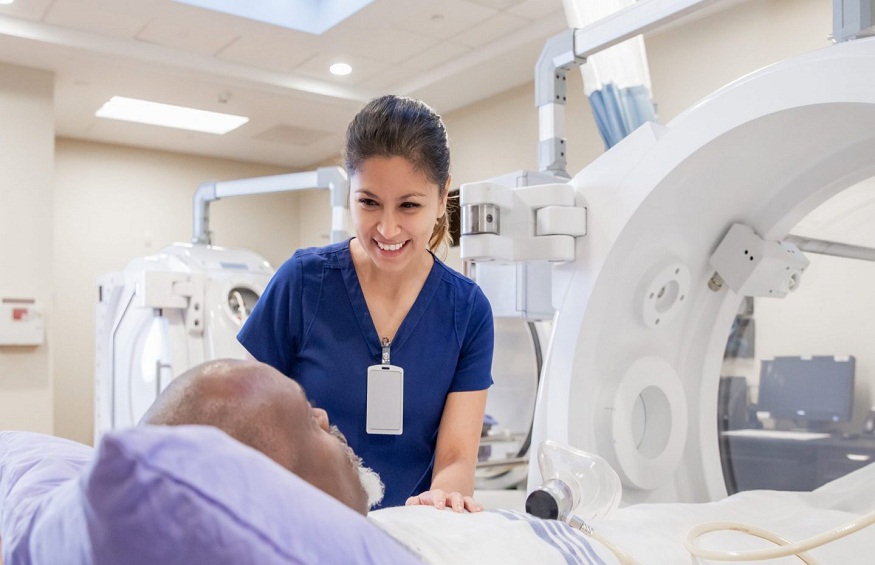Hyperbaric Wound Care
Hyperbaric wound care involves inhaling and exhaling pure air in a pressurized room or . Hyperbaric oxygen therapy is a treatment for many illnesses. There are other diseases treated with this type of cure and they include dangerous transmission, air bubbles in blood vessels, and wounds that take time to recover which are as a result of diabetes or radiation injury.
When a person is in a chamber where there is hyperbaric oxygen therapy, the air pressure will gradually rise in temperature so as to increase in many times more than normal pressure. If someone encounters this level, lungs can gather more oxygen than would be possible breathing pure oxygen at normal air pressure.
When blood flows it increases oxygen in humans. This helps fight bacteria and stimulate the release of substances called growth factors and stem cells, which promote healing. Body’s tissues need an adequate supply of oxygen to function. When tissue is injured, it requires even more oxygen to survive. Hyperbaric oxygen therapy increases the amount of oxygen that blood can carry. An increase in blood oxygen temporarily restores normal levels of blood gases and tissue function to promote healing and fight infection. Hyperbaric wound care in Keller offers these services for a common resident.
Hyperbaric oxygen therapy is used to treat several medical conditions. And medical institutions use it in different ways. any doctor may suggest hyperbaric oxygen therapy if anyone have one of the following conditions:
- Anemia, severe
- Brain abscess
- Bubbles of air in the blood vessels (arterial gas embolism)
- Burn
- Decompression sickness
- Carbon monoxide poisoning
- Crushing injury
- Deafness, sudden
- Gangrene
- Infection of skin or bone that causes tissue death
- Non Healing wounds, such as a diabetic foot ulcer
- Radiation injury
- Skin graft or skin flap at risk of tissue death
- Vision loss, sudden and painless
The evidence is insufficient to support claims that hyperbaric oxygen therapy can effectively treat the following conditions:
- AIDS/HIV
- Allergies
- Alzheimer’s disease
- Arthritis
- Asthma
- Autism
- Bell’s palsy
- Brain injury
- Cancer
- Cerebral palsy
- Chronic fatigue syndrome
- Cirrhosis
- Depression
- Fibromyalgia
- Gastrointestinal ulcers
- Heart disease
- Heatstroke
- Hepatitis
- Migraine
- Multiple sclerosis
- Parkinson’s disease
- Spinal cord injury
- Sports injury
- Stroke
Risks
Hyperbaric oxygen therapy is generally a safe procedure. Complications are rare. But this treatment does carry some risk.
Potential risks include:
- Temporary nearsightedness (myopia) caused by temporary eye lens changes
- Middle ear injuries, including leaking fluid and eardrum rupture, due to increased air pressure
- Lung collapse caused by air pressure changes (barotrauma)
- Seizures as a result of too much oxygen (oxygen toxicity) in their central nervous system
- In certain circumstances, fire — due to the oxygen-rich environment of the treatment chamber
Expect The Following During hyperbaric oxygen therapy
Hyperbaric oxygen therapy typically is performed as an outpatient procedure and doesn’t require hospitalization. If anyone is already hospitalized and requires hyperbaric oxygen therapy, they will remain in the hospital for therapy. Or they will be transported to a hyperbaric oxygen facility that’s separate from the hospital.
Depending on the type of medical institution you go to and the reason for treatment, they may receive hyperbaric oxygen therapy in one of two settings:
Hyperbaric wound care in Keller has a unit designed for 1 person. In an individual (monoplace) unit, they lie down on a table that slides into a clear plastic tube.
A room designed to accommodate several people. In a multi person hyperbaric oxygen room — which usually looks like a large hospital room — they may sit or lie down. they may receive oxygen through a mask over their face or a lightweight, clear hood placed over their head.

